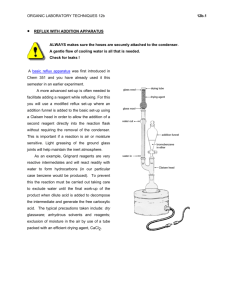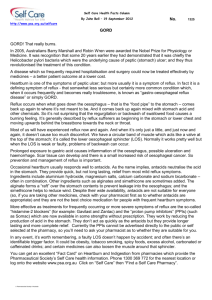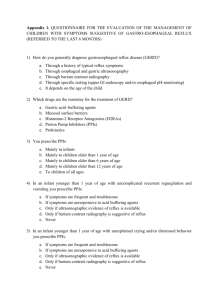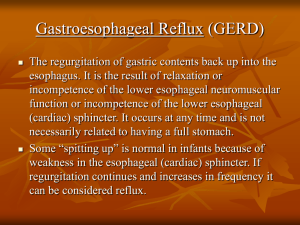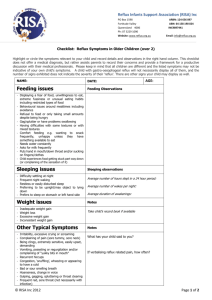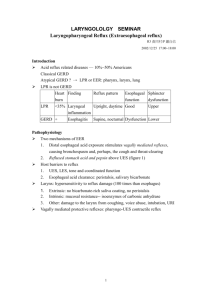pH, Motility & Impendence Studies
advertisement
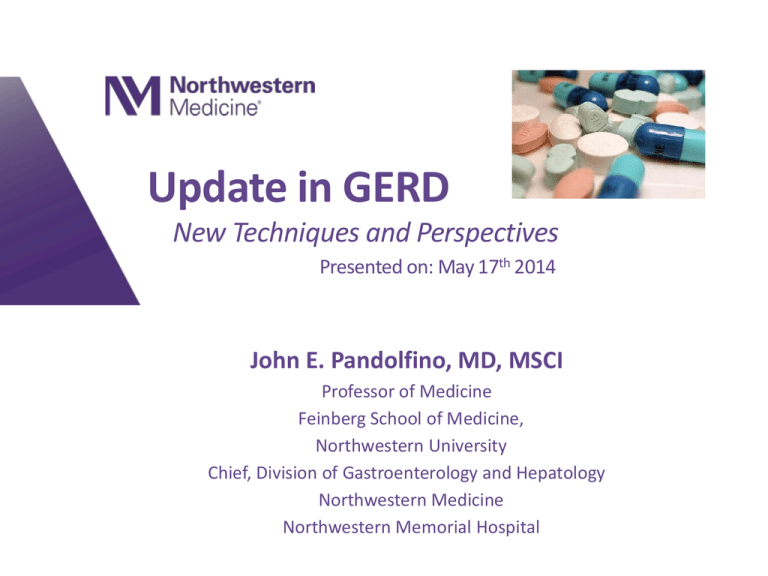
Update in GERD New Techniques and Perspectives Presented on: May 17th 2014 John E. Pandolfino, MD, MSCI Professor of Medicine Feinberg School of Medicine, Northwestern University Chief, Division of Gastroenterology and Hepatology Northwestern Medicine Northwestern Memorial Hospital GERD is a condition which develops when the reflux of stomach content causes troublesome symptoms and / or complications Esophageal Syndromes Symptomatic Syndromes • Typical reflux syndrome • Reflux chest pain syndrome Extra-esophageal Syndromes Syndromes with Esophageal Injury Established Association • Reflux esophagitis • Reflux stricture • Barrett's esophagus • Reflux cough • Adenocarcinoma • Reflux laryngitis • Reflux asthma • Reflux dental erosions Proposed Association • Sinusitis • Pulmonary fibrosis • Pharyngitis • Recurrent otitis media Vakil N et al. Am J Gastroenterol 2006;101:1900 Functional Heartburn/Chest Pain Patient with retrosternal discomfort (heartburn/chest pain) or regurgitation Alarm features? no Heartburn resolved? PPI Trial yes yes Reflux disease: titrate PPI therapy no EGD ± biopsy no Abnormal? no pH or impedance-pH monitoring (off of PPIs) yes Esophagitis EoE >5% esophageal acid exposure? yes yes MII-pH monitoring (on PPIs) NERD no Esophageal manometry Positive symptom association? no Meets esophageal motor disorder criteria? yes Achalasia DES Kahrilas PJ & Smout AJPM. Am J Gastroenterol 2010;105:747 Functional Heartburn/Chest Pain Patient with retrosternal discomfort (heartburn/chest pain) or regurgitation Alarm features? no Heartburn yes resolved? PPI Trial yes Reflux disease: titrate PPI therapy no EGD ± biopsy Abnormal? no pH or impedance-pH monitoring (off of PPIs) yes Esophagitis EoE >5% esophageal acid exposure? yes yes NERD no Positive symptom association? Kahrilas PJ & Smout AJPM. Am J Gastroenterol 2010;105:747 Phenotyping PPI Non-responders: Low pre-test probability of refractory GERD Bravo capsule placed 6cm above SCJ Pandolfino et al. Am J Gastroenterol. 2003 Apr;98(4):740-9 Phenotyping PPI Non-responders: High pre-test probability of refractory GERD 10000 ohms 17 cm 15 cm Bravo capsule placed 6cm above SCJ 9 cm 7 cm 5 cm 3 cm 0 ohms 0 15 30 45 60 Time (Seconds) Pandolfino JE, Vela, MF. Gastrointest Endosc. 2009 Apr;69(4):917-30, PPI Non-responders are Heterogeneousg EGD n • Acid Reflux Symptoms – Abnormal acid exposure – Hypersensitive [(+) S-R correlation] • Non-acid Reflux Symptoms – Volume refluxers – Hypersensitive [(+) S-R correlation] • Overlap between well-controlled GERD and Functional Esophageal Disorder • Do Not Have Reflux at ALL – Functional heartburn….or just functional – Unrelated disease (EoE, EMD, Cardiopulm etc..) Pandolfino JE, Vela, MF .Gastrointest Endosc. 2009 Apr;69(4):917-30, Evolution of the Hydrostat: EndoFlip™ Kwiatek et al. J Gastrointest Surg. 2010 Feb;14(2):268-76 Gastroesophageal Reflux Disease True Refractory Symptoms •Targets for therapy based on our observations Alter EGJ mechanical properties • Surgery • Endoscopic procedures Medications • Promotility agents • Reflux inhibitors Pandolfino JE, Krishnan, K. . Clin Gastro Hepatol. 2013 Jun 28. : S1542-3565 Functional Heartburn/Chest Pain Patient with retrosternal discomfort (heartburn/chest pain) or regurgitation Alarm features? no Heartburn resolved? PPI Trial yes yes Reflux disease: titrate PPI therapy no EGD ± biopsy no Abnormal? no pH or impedance-pH monitoring (off of PPIs) yes Esophagitis EoE >5% esophageal acid exposure? yes yes MII-pH monitoring (on PPIs) NERD no Esophageal manometry Positive symptom association? no Meets esophageal motor disorder criteria? yes Achalasia DES Gastroesophageal Reflux Disease Symptom perception Visceral Sensitivity Hypervigilance Psychosocial factors MF HV PD VS Abnormal Motor Function Case : Functional Heartburn Case : Visceral Hypersensitivity MF PD HV HV VS Gut-directed Hypnotherapy Are you getting sleepy? • Deep physical relaxation and deep mental concentration • Alters focus of attention, changes meaning about sensations arising from the gut and encourages body to restore itself to a healthier state • Shown to produce cognitive change and improve pain tolerance • Modifies physiological arousal and hypersensitivity over long-term • Initially performed in a doctors office but can eventually be self-guided • The most scientifically supported nondrug treatment for Functional GI disorders GERD: Pitfalls • Patients may have a good response to PPI and not have GERD. • Patients may have a positive pH study and not have GERD. • Patients may have a good symptom correlation on pH-impedance testing and not have GERD. • Be careful with belching, regurgitation and nausea/vomiting. tLESR Liquid reflux LES relaxation and crural inhibition NU IRB Rumination # 1 HRM only Liquid reflux Increased IGP pressure NU IRB Rumination #2 HRIM Regurgitation with swallowing Liquid reflux Increased IGP pressure NU IRB Supragastric Belching Air reflux No LES relaxation NU IRB GERD: Pitfalls Gastroesophageal Reflux Disease Conclusions •Reflux testing is essential to phenotype the patient based on mechanism. Refractory reflux Reflux sensitivity Functional heartburn Alternative diagnosis- HRIM is extremely helpful Gastroesophageal Reflux Disease Conclusions • Phenotype will dictate therapies Refractory reflux • Endoscopic/surgery Reflux sensitivity • Motility agents, TCA, HYPNOSIS Functional heartburn • TCA, CBT, Hypnosis Rumination syndrome/supragastric belching • Biofeedback, CBT, hypnosis Thank You
